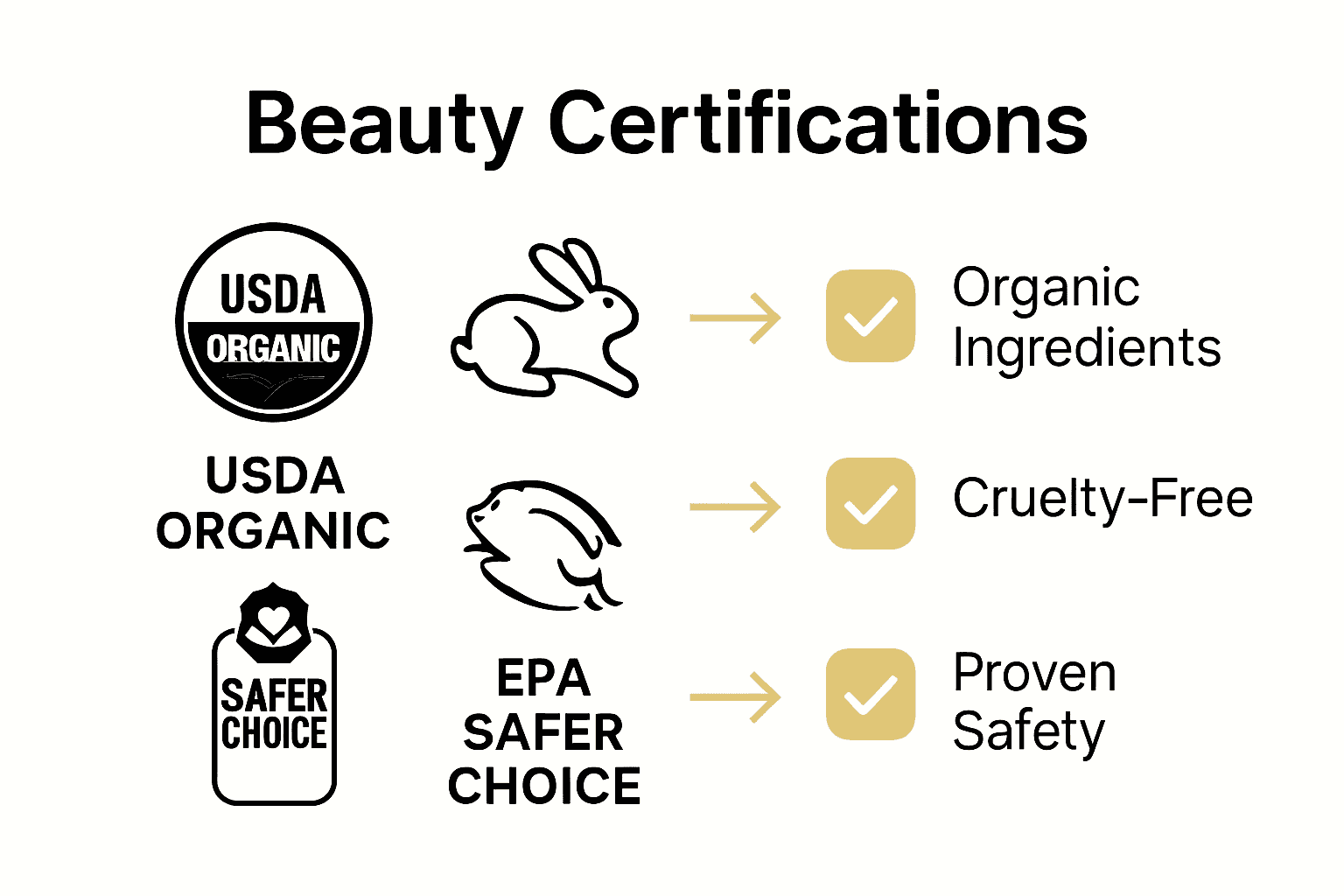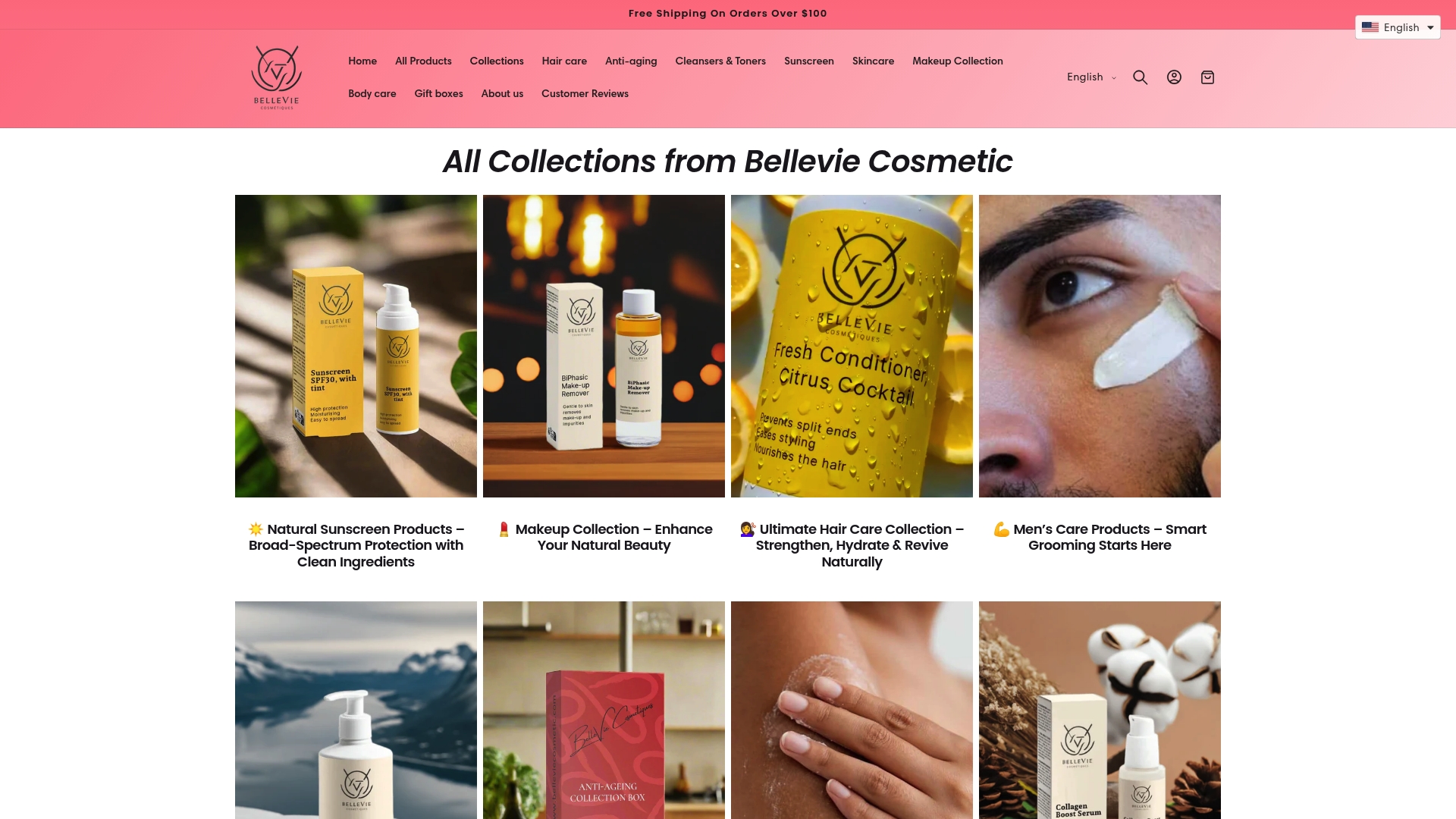Nearly 70 percent of beauty consumers consider sustainability when making purchases, shaping how brands develop products and source ingredients. People want more than just eco-friendly packaging or clean formulas. Today, beauty sustainability brings together ethics, wellness, and environmental care at every step from farm to shelf. Discover how new standards and creative approaches are changing what it means for your favorite skincare and cosmetics to be truly sustainable.
Key Takeaways
| Point | Details |
|---|---|
| Holistic Definition of Beauty Sustainability | Sustainable beauty encompasses ethical production, environmental protection, product integrity, and consumer health across all beauty products. |
| Innovative Practices | Key sustainable beauty practices include upcycled ingredient sourcing, circular packaging, and waterless formulations to reduce environmental impact. |
| Certification Importance | Recognized certifications like USDA Organic and Leaping Bunny validate sustainable practices and inform consumers about product safety and ethical standards. |
| Informed Consumer Choices | When selecting sustainable beauty products, prioritize ingredient transparency, eco-labels, and brands with ethical production commitments to enhance personal and environmental wellness. |
Table of Contents
- Defining Beauty Sustainability and Its Principles
- Types of Sustainable Beauty Practices
- Key Ingredients and Packaging Innovations
- Eco-Friendly Standards and Certifications
- How to Choose Sustainable Beauty Products
Defining Beauty Sustainability and Its Principles
Beauty sustainability is an evolving concept that goes beyond traditional environmental considerations. Sustainable beauty represents a holistic approach to skincare and cosmetics that prioritizes ethical production, environmental responsibility, and consumer wellness. According to the Innova Beauty report, the definition varies significantly across different regions and demographics.
The core principles of beauty sustainability encompass several key dimensions:
- Environmental Protection: Reducing carbon footprint through sustainable packaging, responsible ingredient sourcing, and minimizing waste
- Ethical Production: Ensuring fair labor practices, supporting local communities, and maintaining transparent supply chains
- Product Integrity: Using natural, organic ingredients that are cruelty-free and biodegradable
- Consumer Health: Creating products that are safe, non-toxic, and promote overall wellness
For consumers, beauty sustainability is not just about the end product but the entire lifecycle of cosmetic and skincare items. This means considering everything from raw material extraction to packaging disposal, with an emphasis on minimizing environmental impact while maintaining high-quality, effective products. Our holistic beauty guide offers deeper insights into these interconnected principles that are reshaping the beauty industry.
Types of Sustainable Beauty Practices
Sustainable beauty practices are rapidly evolving, offering innovative approaches that address environmental concerns while delivering high-quality skincare solutions. Upcycled beauty has emerged as a groundbreaking trend, representing a creative strategy to minimize waste and maximize resource efficiency in the cosmetics industry.
Key types of sustainable beauty practices include:
-
Upcycled Ingredient Sourcing: As highlighted by Cosmetics Business, upcycled beauty utilizes materials that would typically be discarded, transforming potential waste into valuable skincare ingredients. The Upcycled Certified™ standard has been instrumental in verifying these practices through rigorous environmental benefit criteria and traceable supply chains.
-
Circular Packaging Systems: Implementing recyclable, biodegradable, or refillable packaging that reduces single-use plastic waste
-
Waterless Beauty Products: Developing formulations that minimize water consumption and reduce transportation emissions
-
Carbon-Neutral Production: Investing in renewable energy and carbon offset programs to neutralize manufacturing environmental impact
Beyond ingredient innovation, sustainable beauty practices also encompass ethical production methods and transparent supply chains. The future of ethical skincare represents a holistic approach that considers environmental, social, and personal wellness interconnections. Consumers are increasingly demanding products that not only perform effectively but also demonstrate genuine commitment to sustainability across every stage of production.

Key Ingredients and Packaging Innovations
Sustainable beauty is revolutionizing skincare through groundbreaking ingredient sourcing and packaging technologies that minimize environmental impact while maintaining product efficacy. At the forefront of this transformation are innovative approaches that reimagine how beauty products are formulated, packaged, and consumed.
Sustainable Ingredient Innovations
- Plant-Based Actives: Utilizing regeneratively sourced botanical ingredients that support ecosystem health
- Biotechnology-Derived Components: Developing lab-grown ingredients that reduce agricultural strain
- Upcycled Natural Extracts: Transforming food industry byproducts into potent skincare ingredients
Packaging Transformation
According to HAPPI Magazine, waterless beauty formulations are dramatically reshaping product development. These innovative approaches dramatically reduce water use and related transportation emissions by creating single-dose or dry formats where consumers actively participate in product preparation.
The packaging innovations extend beyond just material selection. Our guide to skincare packaging highlights emerging trends like:
- Biodegradable packaging materials
- Refillable container systems
- Minimalist design reducing overall material consumption
- Carbon-neutral production processes
These innovations represent more than aesthetic choices—they’re a comprehensive approach to reducing environmental impact while delivering high-performance skincare solutions that meet modern consumers’ expectations for sustainability and effectiveness.
Eco-Friendly Standards and Certifications
Here’s a comparison of major sustainable beauty certification standards:
| Certification | Focus Area | Key Features |
|---|---|---|
| EPA Safer Choice | Ingredient Safety | Strict ingredient review 2,000+ certified products Human health criteria |
| Green Seal | Sustainability | Performance & health benchmarks Comprehensive product standards |
| USDA Organic | Agricultural Origin | Organic ingredient sourcing Transparent processing methods |
| Leaping Bunny | Cruelty-Free | No animal testing Recognized global standard |
| B Corp Certification | Social & Environmental Impact | Corporate responsibility Overall sustainability criteria |
Sustainable beauty certification is a complex landscape of rigorous standards designed to validate environmental claims and protect consumer interests. These certifications serve as critical markers of genuine commitment to ecological and health-conscious practices in the beauty industry.
Key Certification Standards
According to the U.S. EPA Safer Choice program, environmental certification goes far beyond surface-level claims. Their label rigorously reviews every intentionally-added ingredient for strict environmental and human health criteria, with over 2,000 products currently meeting these demanding standards. This voluntary but authoritative ecolabel represents a gold standard in product safety and sustainability.
Other prominent certification standards include:
- Green Seal: A non-profit ecolabel that certifies products based on comprehensive performance, health, and sustainability benchmarks
- USDA Organic: Verifying agricultural ingredient sourcing and processing methods
- Leaping Bunny: Confirming cruelty-free production practices
- B Corp Certification: Evaluating overall environmental and social corporate responsibility
Our guide to ethical skincare highlights that these certifications aren’t just marketing tools—they’re complex validation processes that require brands to demonstrate genuine commitment to sustainable practices. Consumers can trust these labels as reliable indicators of a product’s true environmental and ethical credentials, transforming purchasing decisions from mere transactions to meaningful environmental statements.

How to Choose Sustainable Beauty Products
Sustainable beauty shopping requires a strategic approach that goes beyond aesthetic preferences, focusing on environmental impact, ingredient safety, and ethical production. Consumers today are empowered to make informed choices that align with their values and contribute to broader ecological responsibility.
Key Selection Criteria
When evaluating sustainable beauty products, consider these critical factors:
- Ingredient Transparency: Look for brands that clearly list all components and their origins
- Certifications: Prioritize products with recognized eco-labels like USDA Organic, Leaping Bunny, or EPA Safer Choice
- Packaging: Seek minimal, recyclable, or refillable packaging designs
- Ethical Production: Research brand commitment to fair labor practices and environmental standards
According to the Washington State Toxic-Free Cosmetics Act, ingredient safety is becoming increasingly regulated. Effective January 1, 2025, this legislation bans nine toxic chemicals from cosmetics, signaling a growing trend toward stricter consumer protection in the beauty industry.
Our guide to financially sustainable beauty suggests additional strategies for conscious consumers:
- Invest in multi-purpose products that reduce overall consumption
- Choose concentrated formulas that require less packaging
- Support brands with transparent supply chains
- Prioritize products with longer shelf lives to minimize waste
Ultimately, choosing sustainable beauty products is about making mindful decisions that balance personal wellness with environmental responsibility. Each purchase becomes an opportunity to support brands committed to genuine ecological and ethical practices.
Elevate Your Beauty Ritual With Authentic Sustainability
You came here because you care about more than surface claims. This article explores the growing need for sustainable beauty, from ingredient transparency to eco-conscious packaging and trusted certifications. Many shoppers face the frustration of greenwashing and uncertainty about which brands truly uphold ethical, safe, and eco-friendly standards. It can be overwhelming to identify products that protect your skin and the planet at the same time.

Meet a new way to shop skincare with confidence. At Belle Vie, you will find natural, organic, and cruelty-free formulas that align with every principle of beauty sustainability discussed above. Each collection, from Anti-Aging Moisturizers to Natural Cleansers, is made with transparent sourcing, safe ingredients, and eco-friendly practices. Our commitment to honest skincare means no harsh chemicals and no empty promises. Ready to make a change that benefits your skin and our world? Explore all our sustainable collections now to find your next favorite clean beauty essential before our exclusive new customer offer ends.
Frequently Asked Questions
Why is beauty sustainability important?
Beauty sustainability is essential because it focuses on reducing the environmental impact of skincare and cosmetic products. It includes ethical production, responsible ingredient sourcing, and consumer health, ensuring that beauty products benefit both consumers and the planet.
What are some key principles of sustainable beauty?
Key principles of sustainable beauty include environmental protection through waste reduction, ethical production practices, product integrity with natural ingredients, and prioritizing consumer health by ensuring products are safe and non-toxic.
How can I identify sustainable beauty products?
To identify sustainable beauty products, look for transparency in ingredient sourcing, certifications like USDA Organic or Leaping Bunny, packaging that minimizes waste, and brands that have a clear commitment to ethical production practices and environmental standards.
What are upcycled ingredients in beauty products?
Upcycled ingredients are materials that would typically be discarded but are repurposed into skincare products. This practice minimizes waste and contributes to resource efficiency, allowing brands to create effective products from ingredients that would otherwise go unused.
